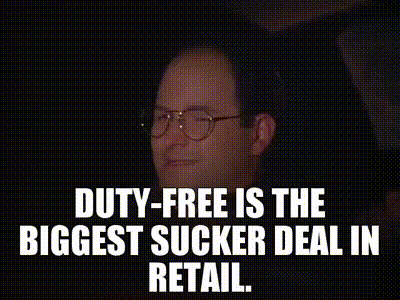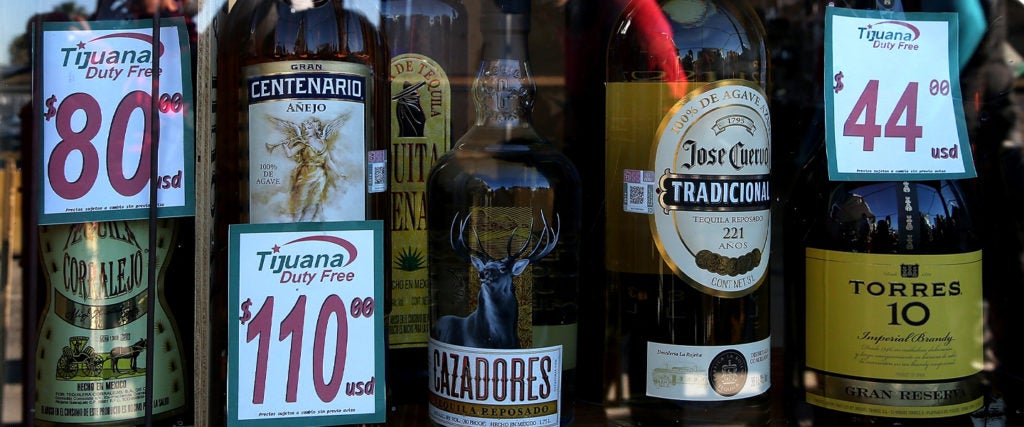They’re in every large airport, gleaming magnificently, often covered in mirrors. In some foreign ports of entry, you even have to walk through them. Duty-free shops: What a weird idea, right? They’re inevitably filled with seemingly random, yet seemingly always the same stuff that’s supposedly tax exempt — an unlikely assortment of alcohol, perfumes, cosmetics, jewelry, watches, sunglasses, smokes and Toblerone bars, all immaculately stacked on the shelves.
What’s the story with these weird airport malls? Why are they everywhere? Is duty-free cheaper, really, or are they some kind of scam (as inveterate scammer George Costanza once proclaimed)? And can you just buy a fifth of whiskey for the plane ride rather than be forced to knock back the high-priced miniature bottles for sale in the cabin?
We investigated!

What’s up with these stores anyway? Is duty-free cheaper than anywhere else if I want to stuff my luggage with booze, cigarettes and candy bars?
Some quick history first: The original duty-free store was started in Ireland in 1951 at Shannon Airport. What, you’ve never heard of Shannon Airport? It used to be a much bigger deal because in the 1940s and 1950s, as the closest European airport to the U.S., Shannon, Ireland, was the last stop for transatlantic flights going west, and every plane would stop there to refuel. Think about it — every politician, celebrity, royal and rich person on their way to America passed through there.
A caterer at the airport named Brandon O’Regan had the bright idea to do what cruise ships were already doing — selling stuff in international waters that were exempt from local taxes. He thought these rich people might like to buy some local stuff at cheap prices. The government agreed to let him do it, and he sold local products like ham, honey, eggs and whiskey. The eggs didn’t sell so well, but the whiskey did, and it’s not hard to see why: It was sold for a third of its price outside the airport!
Amsterdam then opened a duty-free shop in 1957, and the concept made it to the U.S. in 1962 — from which point on we’ve been blessed with them as an airport fixture.
How’s the duty-free thing work?
Oh, well, it’s fairly simple. Customs duty is a tax on items moved across international borders. Duty-free zones are places where products are sold with the understanding that the buyer is going to consume the product outside of the country — and so import, sales, value-added and other taxes are waived. That’s why you find them at airports, sea terminals and international train stations, and why stuff is sold duty-free while on the ocean or up in the air. That’s also why the marquee items happen to be stuff that most governments slap all kinds of taxes on — namely booze and tobacco, as well as imports like Swiss chocolate.
They seem to be everywhere.
You’re not wrong! Just the revenues of liquor sales alone in duty-free shopping was $2.8 billion in 2018, and that’s expected to grow annually by 9.4 percent to $3.7 billion by 2026.
So is duty-free worth it, or are they some kind of scam?
They’re not a scam, although they don’t always offer much of a deal, either! It all depends. Of course, what they seem to rely on is the kind of customer psychology that Costco likes to call “pricing authority,” meaning people automatically assume that places like these have the lowest prices. They’re not selling items at wholesale cost, though — they still mark-up the prices, as they face typical retail overhead costs. Plus the airport gets to wet their beak a little bit as well.
Are there deals to be had in these blindingly bright stores, then?
The Points Guy did what seems to be a pretty exhaustive survey of 50 duty-free stores in airports worldwide. They found that while duty-free isn’t necessarily a good deal, especially once you factor in currency exchange rates, there are serious deals to be had at specific airports. Many stores show their prices online, by the way, so there’s plenty of transparency in the market (and there’s also this website). Still, prices can vary wildly — e.g., Jack Daniels is 30 percent more at a duty-free shop in London’s airport than at one in Madrid.
A few general rules they found regarding the lowest prices: Buy alcohol in the Caribbean, cosmetics and fragrances in Europe, and tobacco in Asia. Likewise, the reverse is true: Just as you wouldn’t bring sand to the beach, don’t bother buying rum at a duty-free store in the U.S. when you’re on your way to the Caribbean, for example. You’ll probably find it cheaper basically anywhere on the island than you will at a duty-free shop in the States.
Overall, though, for Americans traveling internationally, Vinepair says liquor can be discounted 25 to 50 percent at duty-free shops, while the BBC says makeup can be up to 50 percent off.
Aren’t customs agents gonna steal my bottle of Johnnie Walker?
Yes, it can happen. American rules state that a U.S. resident can return to the country with up to $800 of stuff bought overseas, as long as it’s for personal use. (And you’ll have to declare any amount of alcohol over a liter.) But if you’re traveling as part of a multi-stop journey throughout different countries, beware that you’re subject to the local laws of the land, like the size limit of liquids you can bring onto a plane — which for most journeys isn’t an issue, since duty-free stores sell alcohol and bottles of cologne on the other side of security. But if you’re skipping around airports on a complicated itinerary and the local authorities find a large bottle on you, they may just exercise whatever power they have, whether it’s actually legal or extrajudicial.
Okay, can I actually buy duty-free booze and drink it on the plane?
This is a tricky question! Let’s unpack what the law says. According to the FAA, “No person may drink any alcoholic beverage aboard an aircraft unless the certificate holder operating the aircraft has served that beverage to him.” So not only is it pretty much illegal to drink your own alcohol on a plane, but according to The Points Guy, U.S. airlines are required to follow FAA regulations at all times — even when their planes are flying over foreign airspace.
And yet! FAA regulations can’t keep a good drinker down. Several airlines say they’ve noticed an increase in passengers allegedly drinking their own alcohol, particularly as some of them stopped serving in-flight drinks altogether during COVID. So, clearly, people are doing it. Southwest has even recently added a bit in the pre-flight lecture that no one ever listens to anyway about not drinking your own alcohol on board.
One place you can apparently drink your own booze in mid-air is on JetBlue. Those geniuses figured out a clever way around the rule. Just present your alcohol to them first and they’ll serve it to you, which seems to be perfectly in line with the law.
So next time I’m wondering, is duty-free cheaper, I can be reassured that it… kinda is?
Yeah — just be sure you convert the currency the right way, pay for things with a credit card that doesn’t charge foreign transaction fees, and shop around at the different stores if you can (or check their prices online). Of course, it helps to know what that item costs where you’re going, or at least what it costs when served on an airplane. Although if what you’re really craving is a giant triangular yardstick of Toblerone, then say no more — you’ve come to the right place indeed.

